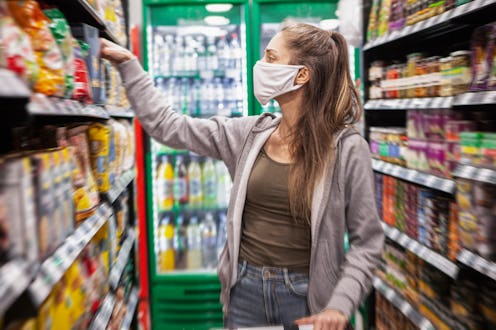Health
This Is The Best Time To Do Your Pandemic Grocery Shopping
It may not be the *most* convenient, but…

No matter what COVID case numbers in your area are like, you still need to eat — but these days, a trip to the grocery store needs a little more forethought than "grab keys, remember multi-use shopping bags, go." Figuring out the best time to go grocery shopping in the pandemic, and how to do it in the safest possible way, can feel like a headache-inducing math problem. But, experts tell Bustle, it just takes a little homework.
If you can afford it, experts recommend using online shopping. “Shopping online or using shopper services that delivers to your door is the absolute safest way," Dr. Teresa Bartlett M.D., senior medical officer at claims management company Sedgwick, tells Bustle. Using online shopping services is an even better idea if you're high-risk, or have somebody in your bubble who is.
These services, of course, cost more money than going to the grocery store yourself. They also expose shop service workers to the risk of COVID-19, which can be ethically tricky. Sarah Polito, an Instacart worker, told Bustle in April, "We're putting our lives or at least our health at risk. And we're trying to look out for the customers as well." Dr. Robert Quigley M.D., global medical director of health and security risk mitigation firm International SOS, tells Bustle, "If you are someone who falls into a high-risk category then have a friend, neighbor, or family member grocery shop for you."
If you prefer to go to the market yourself, safe grocery shopping is a matter of timing. "One way to have a safer shopping experience at the grocery store is to try to go on off hours when there are fewer people," Dr. Bartlett says. She suggests calling ahead to see what times are less popular at your local market. Google Maps published data in November based on user movement, which found that supermarkets tend to be busiest on Saturdays between 12 and 3 p.m., and least busy on Mondays at 8 a.m., just as they open.
A study published in Nature in November found that socioeconomic factors play a role in your risk at your local grocery store, too. Using phone tracker data, the study found that people in low-income neighborhoods were less able to socially distance at grocery stores, and that more people used them at the same time, raising their COVID risk. If your only option for affordable groceries is always packed and can't put in social distancing measures, you're going to face different risks than people who can walk into their choice of spacious supermarket.
The goal of choosing an off-peak hour to go grocery shopping is to reduce your risk of exposure to others, but you can also take risk-mitigating measures no matter what time you shop. When you're at the grocery store, Dr. Bartlett suggests wearing a mask that fully covers your nose and your mouth — no peeking nostrils, please — and trying to turn away from people who are passing you in aisles. Do your best to stay 6 feet or more away from others, use hand sanitizer, and try not to touch your face or eyes until you've come home and washed your hands. Try not to pick up or put down items while idly browsing, if you can help it. "Although transmission of the disease is more likely through respiratory droplets and aerosols, research has shown that the virus can live on inanimate objects and surfaces," Dr. Quigley says. Plan your grocery shop like a military campaign: in and out with a minimum of time, fuss, and exposure. Dr. Quigley also recommends sanitizing your cart, and particularly its handrail, before and after you use it, if that service isn't provided by the shop itself.
Even if you have to get up at the crack of dawn, shopping in a nearly-empty produce aisle may be worth it.
Experts:
Dr. Teresa Bartlett M.D.
Dr. Robert Quigley M.D.
Studies:
Chang, S., Pierson, E., Koh, P.W. et al. (2020) Mobility network models of COVID-19 explain inequities and inform reopening. Nature. https://doi.org/10.1038/s41586-020-2923-3
This article was originally published on